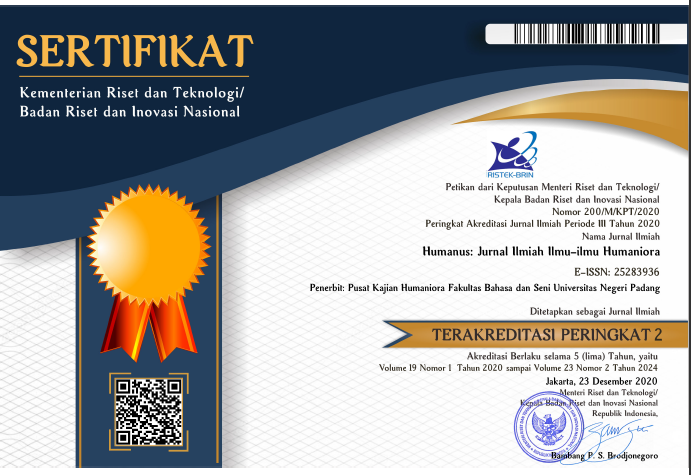PARENTAL ROLE AND NARCISSICM IN CONSTRUCTING SELF-IMAGE IN JOICE CAROL OATES’S SHORT STORY
 ),
), (1) IAIN Surakarta
 Corresponding Author
Corresponding Author
Copyright (c) 2017 Humanus
DOI : https://doi.org/10.24036/jh.v16i1.6656
Full Text:
 Language : en
Language : en
Abstract
POLA ASUH DAN NARSISME DALAM MENGKONSTRUKSI GAMBARAN DIRI DI CERITA JOICE CAROL OATES
Abstract
This research attempts to find the parental role and narcissism in constructing self-image in Where Are You Going Where Have You Been by Joice Carol Oates. This research was qualitative. By using object relation theory, this research finds that less attachment and abandonment leads to depression. To avoid further rejection, self can split to different personalities. Unpleasant experience during maturing process produces low self-esteem. Narcissism works to soothe the anxiety on developing the self-image.
Keywords: abandonment, depression, split personality
Abstrak
Penelitian ini bertujuan untuk menemukan pola asuh orang tua dan narsisme dalam membangun gambaran diri dalam Where Are You Going Where Have You Been karya Joice Carol Oates. Penelitian ini merupakan penelitian kualitatif. Dengan menggunakan teori hubungan objek, penelitian ini menemukan bahwa kurangnya kedekatan dan rasa penolakan memunculkan depresi. Untuk mencegah penolakan lebih lanjut, diri dapat terbagi menjadi karakter yang berbeda-beda. Pengalaman pendewasaan yang tidak menyenangkan dapat menyebabkan anak memiliki rasa penghargaan diri yang rendah. Narsisme bekerja untuk meredakan kegelisahan dalam mengembangkan diri.
Kata kunci: penolakan, depresi, karakter ganda
Keywords
References
Bowlby, J. (1957). An ethological approach to research in child development.British Journal of Medical Psychology.
Bowlby, J. (1958). The nature of the child's tie to his mother.International Journal of Psycho-Analysis. 39, 350-373.
Bowlby, J. (1960). Separation anxiety.International Journal of Psycho-Analysis. 41, 69-113.
Bowlby, J. (1965). Child care and the growth of love. (2d ed.) London: Penguin.
Bowlby, J. (1989). Attachment and loss.Vol. 1.Attachment.London: Hogarth; New York: BasicBooks.
Kernberg, O. (1976). Object Relations Theory and Clinical Psychoanalysis New York: Jason Aronson.
Klee, T. (2007a). Object relations theory: Human development and psychopathology. Retrieved from http://www.objectrelations.org/orhd.htm
Klee, T. (2007b). Object relations theory: Key concepts. Retrieved from http://www.objectrelations.org/orkey.htm
Klee, T. (2007c). Object relations theory: Resolving human conflict. Retrieved from http://www.objectrelations.org/orconflict.htm
Kohut, H. (1971). The analysis of the self.New York: International Universities Press.
Kohut, H. (1977). The restoration of the self.New York: International Universities Press.
Kohut, H. (1978a). Introspection, empathy, and psychoanalysis: An examination of the relationship between mode of observation and theory. In P. Ornstein (Ed.), The search for the self (Vol. 1, pp. 205–232). New York: International Universities Press. (Original work published 1959)
Marshall, G. (1998). Object relations theory. Retrieved from http://www.encyclopedia.com/ doc/1O88-ObjectRelationsTheory.html
Mead, H. G. (1934). Mind, Self and Society. Chicago: University of Chicago Press.
Oates, J. Carol. (1970). “Where Are You Going, Where Have You Been?” The Wheel of Love. New York: The Vanguard Press. Retrieved from http://engl273-finnell.wikispaces.umb.edu.
Riso, D. R., & Hudson, R. (2000). Understanding the Enneagram: The practical guide to personality types. United States of America, USA: American Psychiatric Association. Retrieved from http://books.google.com.my/books?id=vuIW_TIw8BIC&pg=PA315& lpg= PA315&dq=attachment,+frustration+ and+rejection+in+the+Object+Relations+ Theory&source=bl&ots=y1_y02GFx2&sig=PeakBgGELmaTLjYKsPUNyjOPKZw&hl=en&ei=16fBTJDIE8KXcaL_MwN&sa=X&oi=book_result&ct=result&resnum=6&ved=0CCsQ6AE wBQ#v=onepage&q=attachment%2C%20frustration%20and%20rejection%20in%20the%20 Object%20Relations%20Theory&f=false
Weinberger, G. J. (1988). “Who Is Arnold Friend? The Other Self in Joyce Carol Oates’s ‘Where Are You Going, Where Have You Been?’” Americana Imago 45.
Winnicott, D. (1994). Birth memories, birth trauma, and anxiety In Through Pediatrics to Psycho analysis London:Hogarth Press.
Winnicott, D. (1958). Metapsychological and clinical aspects of regression within the psychoanalytical setup In through Paediatrics to Psychoanalysis London: Hogarth Press.
 Article Metrics
Article Metrics
 Abstract Views : 838 times
Abstract Views : 838 times
 PDF Downloaded : 244 times
PDF Downloaded : 244 times
Refbacks
- There are currently no refbacks.
Copyright (c) 2017 Humanus

This work is licensed under a Creative Commons Attribution-NonCommercial 4.0 International License.










